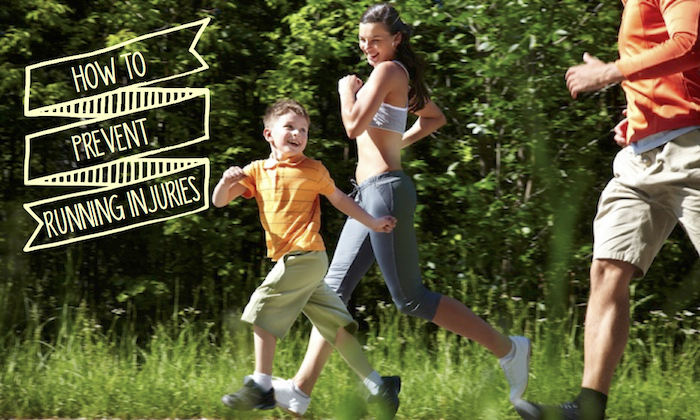




Running is one of the most popular exercise choices among families for many reasons. It requires very little equipment. You can do it together or alone. You don’t need an expensive gym membership. And most importantly, it is one of the best all-round cardiovascular workouts you can do! But there is a downside. Due to the constant pounding nature of running, the risk of injury is very high. Two polls from Runners World have shown that between 60-66% of runners suffer injuries every year. So what are the most common types of running injuries and how can we prevent them?
Shin Splints
Shin splints refer to pain along the “shin bone” or tibia. The pain is often described as a stabbing, burning or aching sensation. It is an inflammation of the muscles, tendons and fascia (tissues) around the tibia. Shin splints usually occur when there are sudden increases in running intensity. They also tend to affect new runners as the leg musculature in beginners have not adapted to the physical stress of running.
Prevention Tip: Experts recommend starting slowly and developing a solid foundation before increasing mileage. Allowing your body to acclimate to these new stresses will lessen the chance of injury. Running on softer surfaces will also decrease the effects of the ground reaction forces. Avoid hills when beginning – the constant slope variations stress the tibialis anterior muscle (the muscle in the front of the lower leg) which can contribute to shin splints. There is also some evidence that cushioned insoles with arch support may help with prevention.
Achilles Tendonitis
Inflammation of the Achilles tendon is very common among runners. The Achilles tendon attaches the heel bone (calcaneus) to the calf muscle. With prolonged running, tight calves and poorly fitted footwear, it can become irritated causing sharp pain and swelling. Tendons are notorious for lacking adequate blood flow, resulting in longer healing times. This is a colossal source of frustration for die-hard runners.
Prevention Tip: In order to avoid falling victim to this bothersome condition, it is advised to stretch the calf muscles pre- and post-workout. Running up slopes also places additional stress to the Achilles, so take it easy on the hills! Over pronation (walking with more pressure on the inner foot) and flat feet can also cause this condition to occur. Many therapists recommend getting fitted for a customised orthotic insole to help with overpronation issues.
Runner’s Knee
Another name for this condition is Patellofemoral Pain Syndrome. Runners describe it as pain occuring underneath the knee cap (patella) or just below it. Occasionally one can feel a grinding sensation with knee movement. It is primarily an overuse injury and worsens as the run progresses. Runner’s Knee is primarily caused by an improperly aligned patella (the patella is attached to the thigh muscle or quadriceps). When there is an muscle imbalance in the quadriceps, the patella will be pulled out of its normal path of movement. The result can be a grinding and wearing down of the cartilage underneath causing pain.
Prevention Tip: To prevent this, it is important to address any muscle imbalances in the thigh and strengthen the weaker muscles to match the stronger ones. Avoid running downhill as it has been known to exacerbate the condition. Shortening your stride may also help to lessen strain to the knees.


Iliotibial Band (ITB) Syndrome
The Iliotibial Band (ITB) is a thick tendon that runs down the side of your thigh joining the hip to the knee. As the boney knee rubs against the ITB during running, inflammation can occur. Many runners describe a stabbing sensation on their outer knee as they run. The pain can be excruciating. Running downhill or on uneven surfaces causes friction between the ITB and the knee. This eventually leads to microtrauma, swelling and tightness of the ITB followed by pain.
Prevention Tip: Loosening the ITB using a foam roller before and after a run will keep the tendon nice and supple. Stretching the hip abductor muscles will also relieve tension along the ITB.
Plantar Fasciitis
This is one of the most common injuries that runners face. The plantar fascia is a fancy name for the thin tissue along the bottom of the foot. This condition is an inflammation of that tissue which results in sharp pain near the base of the heel. The pain is most acute in the morning with that first step out of bed. Runners liken the feeling to stepping on shards of broken glass. While you are sleeping (and not in a weight-bearing position) the fascia begins to heal. Once you wake and stand up, the fascia tears again and pain results. This constant cycle of healing followed by re-injury is extremely disheartening to runners.
Prevention Tip: The key to prevention is to ensure you have appropriate footwear with sufficient cushioning, especially in the heel area. Custom-made orthotics have also been shown to help, as overpronation can result in damage to the delicate fascia. Gently massaging the bottom of the foot before and after a run by rolling on a tennis ball is a great way to warm up. Avoid walking on hard surfaces with bare feet and make sure to strengthen and stretch the calf muscles.
Ankle Sprain
There are two types of ankles sprains. The most common is an inversion sprain, when the foot rolls inward causing a tear in the outer ankle ligaments. An eversion sprain is the opposite, when the foot rolls outward with tearing of the inner ankle ligaments. Both sprains cause severe pain and swelling. With more serious sprains, visible bruising can be seen. It may also be advisable to get an X-ray taken to rule out an ankle fracture. As mentioned previously, ligaments heal very slowly due to a poor blood supply. As a result, runners that suffer a severe ankle sprain are more than likely to have repeat occurrences. Once the ankle ligaments are stretched and damaged, they rarely return to their normal length and elasticity.
Prevention Tip: Avoid running on unstable, slippery surfaces. When running off-road be wary of tree branches, pot holes, wet leaves, etc. Consider adding one-legged balance exercises to improve ankle stabilisation and proprioception (awareness of body position in space).
Following these prevention tips can significantly decrease the risk of these common running injuries, and give you and your family the ability to enjoy the benefits and joys of running for many years to come!
 View All
View All











 View All
View All





 View All
View All


 View All
View All













